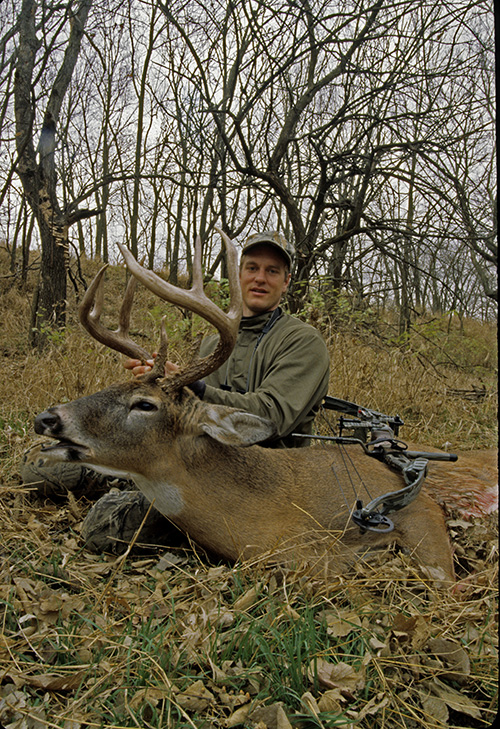BOWHUNTING CREEKS
I shot this buck when hunting a creek bottom in Kansas. The date was November 16, 1994. I used to hunt Kansas with a good friend of mine, named Rod Ponton, who would get me onto some good looking properties. This farm looked really good. Most of the places I hunted didn’t have nearly this much cover.

I shot this buck on November 16, 1994 from a really nice looking creek bottom property. The day was notably windy with gusts pushing 40 mph.
It was a morning hunt and I was in a stand right off the corner of the small field. It was alfalfa that year. A heavy trail came up out of the wooded creek bottom to the west of my stand and cut across the alfalfa field.
I believe I had also hunted it the evening before when I saw a couple of deer out on the alfalfa field, but nothing big.
The morning of the16th was super windy. Kansas is known for windy conditions, and this day would have done the state proud. The gusts were pushing 40 mph and the sustained winds were in the 20+ mph range.
I was in a small tree, probably not much bigger around than my leg at stand height. Even though I was only about 14 feet up, that tree turned into a bucking bronco when the wind gusted.
To keep from flying out if the stand, I had to brace my feet on the platform and press my back against the tree. I sat like this all morning and then pushed back hard every time a gust hit. I am sure the stand was jolting a foot and a half to the side with every gust.
I might just as well have gone to Gilley’s and rode the mechanical bull! As the morning wore on, I got the feeling that a trip to Gilley’s would have produced just as many deer sightings, as well.
Then about three hours after daylight I heard a faint grunt from the creek bottom to the southwest. I got stood up and squared around in time to prepare for a line of three does followed by this really nice 8 pointer.
They weren’t actually coming up to the alfalfa field, but were cutting the corner on another trail, heading toward the north.
I took the shot as they eased along, but the wind hit the tree just as I was releasing the string pushing the arrow back into the liver region on the buck. I knew the hit was back, but I also knew it was lethal. Unfortunately, I also knew it would take some time to kill the buck.

This was one of the best looking creek bottom properties I ever hunted. Most had much less cover. My friend got me permission to hunt it and I only hunted it one year (for some reason). The blue line is the travel of the buck before the shot, the red line after the shot. You can see how far he went after the shot.
Rather than climb down, I decided to stay on the stand and just see what happened. Rod was working, so I figured I would wait until his noon break to go get him to help trail the buck.
After nearly two hours of just sitting there, I happened to see a deer cutting along the fence line to the north of the stand heading to the east. It sure looked like my buck, but what was he still doing on his feet?
I was surprised and almost wrote it off as a different deer.
When it came time to track the buck, Rod and I found zero blood! And I didn’t find the arrow. It was amazing. I knew I had hit him, but where was the sign? I still don’t know.
We searched the creek heading north without any blood. Then I remembered the deer I had seen on the other side of the fence – going east.
Rod and I walked the fence line and found just one small spot of blood to verify that it was, indeed, my buck. We continued to the east to the larger patch of cover and started to sneak in.
I spotted the buck bedded 75 yards ahead and crept to within 20 yards, using the high wind to cover my approach. I finished him with another arrow.
LESSONS LEARNED
The stand site itself was nothing really special. I was just watching the right trail at the right time. I like to hunt bedding areas in the mornings, but in that creek bottom country, with such limited cover, it is hard to know where the bedding areas are. The deer can (and do) bed almost anywhere. So I was just hunting a trail and hoping for the best.
The first lesson, is the fact that I might not have found that buck had I not stayed on stand after the shot watching. Maybe we would have eventually made it over to that other patch of cover, but it would have been after a long day of first searching the creek bottom the buck went up and the CRP field that lay to the north of it.
Without blood, that trail would have been tough to unravel. Sometimes, especially in that open country, staying on stand after the shot can reveal information that will make a huge difference in your success when going to recover the deer.
The second lesson had to do with the wind. Most people think that bucks don’t move on windy days. That has not been my experience. This may be true in some areas, but certainly not in much of the Midwest where wind is a common occurrence. I wouldn’t let wind ever keep me from hunting during the rut unless it was just so windy that it was unsafe.
